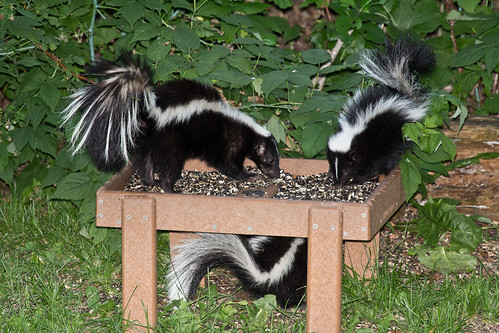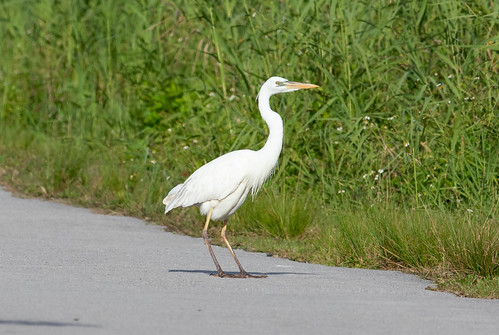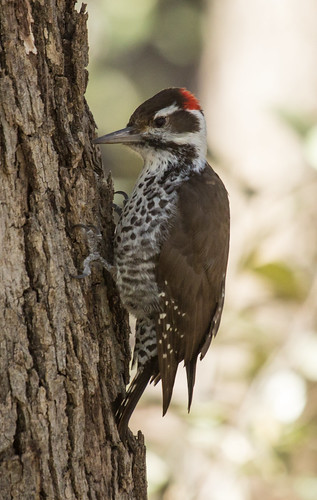 |
| This Cornell student, Carolyn Sedgwick, is examining this chickadee's feathers for lice, mites, and stress marks. |
When I was a wildlife rehabber, I noticed that when I was brought nestlings or fledglings still growing in their feathers, they usually ended up with wing and tail feathers that had a weird section structurally weaker than it should have been. That section seemed wider in birds that had been injured or were cared for by someone without knowledge about proper baby bird diets.
I worked out that during the period that that section of feather was developing, the bird must not have been eating properly or was otherwise stressed, affecting each feather right at the point when it had been growing. Sure enough, when I spent time with bird banders, I learned that they examine bird feathers for those very striations, which they called stress marks. Even in healthy adult birds, these marks can indicate a stressful environmental situation—drought or a long storm system that made it hard to get adequate nutrition—during the bird’s previous molt.
Anyone looking at the human population right now might notice something that looks like stress marks in the plumage of some older individuals. Take me, for example. The hair growing in from my scalp is virtually all white, while before the pandemic hit, it was brown. Along my part, you can see what I’m calling a “skunk stripe,” which could easily be mistaken for a stress mark by a competent but too-narrowly-focused bird bander.
My hair has never been anywhere near as black as a skunk’s fur, and in recent years it’s been a significantly lighter shade of brown, so I’m assuming that when passing people give me a wide berth lately, it’s because they’re social distancing to protect us from virus transmission, not because they’re misidentifying my species.
 |
| These are my backyard skunks here in Duluth, Minnesota |
Over the weeks, my skunk stripe has gotten wider and wider. Intriguingly, I learned last week from my good friend Erik Bruhnke, who is now living in New Jersey, that the white stripe of skunks out East is wider than that of our Midwestern skunks--I hadn't noticed that, though I took photos myself of skunks when I was in New York working at the Cornell Lab of Ornithology.
 |
| This skunk was at the Montezuma National Wildlife Refuge in Upstate New York. |
So as my skunk stripe widens, I’m apparently going to be looking increasingly like the Eastern subspecies.
Like avian stress marks, this development, not at all unique to me, really is indicative of a sudden upheaval—in this case, nothing dangerous, but simply the suspension of professional grooming. As robins grow older, they often grow some white feathers, but like the normal growth of gray hair, this is a gradual process and those feathers are simply mixed in with their normal plumage. In several species, white feathers may grow in over damaged tissue—sometimes this happens in just the first one or two molts after an injury, but sometimes it’s permanent.
On the opposite end of the spectrum from humans, several different kinds of birds go from white to dark. Many hawks and falcons start out with adorable, fluffy white baby down that will be quickly pushed out by their juvenal plumage.
Little Blue Herons leave the nest with adult-looking white feathers. They’ll molt out of them and into their dark bluish feathers in a few months. Reddish Egrets and Great Blue Herons both have a subspecies that is entirely white, but that condition lasts throughout their lives.
 |
| Great White Herons are sometimes easy to find on the Anhinga Trail in Everglades National Park. Scientists consider this a form of the Great Blue Heron. |
Like a baby Arizona Woodpecker, I started out entirely bald, but then my plumage grew in brown.
I noticed a few gray hairs in my 30s, and decided to get them colored, “just this once,” for my 40th birthday. My mother-in-law took me out to lunch that day and did not notice that I’d had it colored. I told her Russ would—I’d been complaining about going gray for a while—but she said husbands never notice such things. I bet her a quarter that he would, but when he came home and I asked if he noticed anything new, even actually pointing at my hair, he was oblivious, so I had to fork over the quarter.
That would have been that, and from then on I’d have let the gray grow in gracefully, but right then our ten-year-old son Joey walked in the door and instantly exclaimed, “Mom! Your gray hair’s all gone! Oh, I’m so relieved!” That was the year my father-in-law had died, and it hadn’t occurred to me that after losing their grandpa, the kids were worrying about Russ and me getting older. For them, gray hair was a sign of impending doom.
So the first time I colored it, my entire motivation was 40th birthday vanity, but for the next 28 years, I kept going back. At first I figured that when the kids were done with college I could stop worrying about their fears of mortality, but the last graduation was more than a decade ago. It turns out to be tricky letting it go gray after so many years of coloring it. Under that hair dye, at least 90 percent of my hairs are now white. Until I can get a haircut, the exact point where I stopped getting it colored will be obvious.
Starting July 1, I’ll be hosting Zoom presentations for my Patreon supporters on the first of each month. I’ll be answering questions and will be able to show photos and videos—something I can’t do on the radio—as well as presenting some of my more popular speaking engagement topics. Zoom’s video component means that my guests will be able to watch what I’m calling my “mustelid transformation” as my skunk stipe get wider and wider. Before the pandemic, my hair was pretty much the color of a river otter, which, like skunks and weasels, is in the mustelid family. I gradually transformed into a striped skunk of the Midwestern persuasion, and am now more of an East Coast striped skunk. In a few months, when those of us high-risk people can start safely visiting our hairdressers again, she’ll help me make that final mustelid transformation, into an ermine. And forever after, I’ll be able to truthfully say that Covid-19 turned my hair white.
 |
| This gorgeous photo was taken by my dear friend Erik Bruhnke. |



